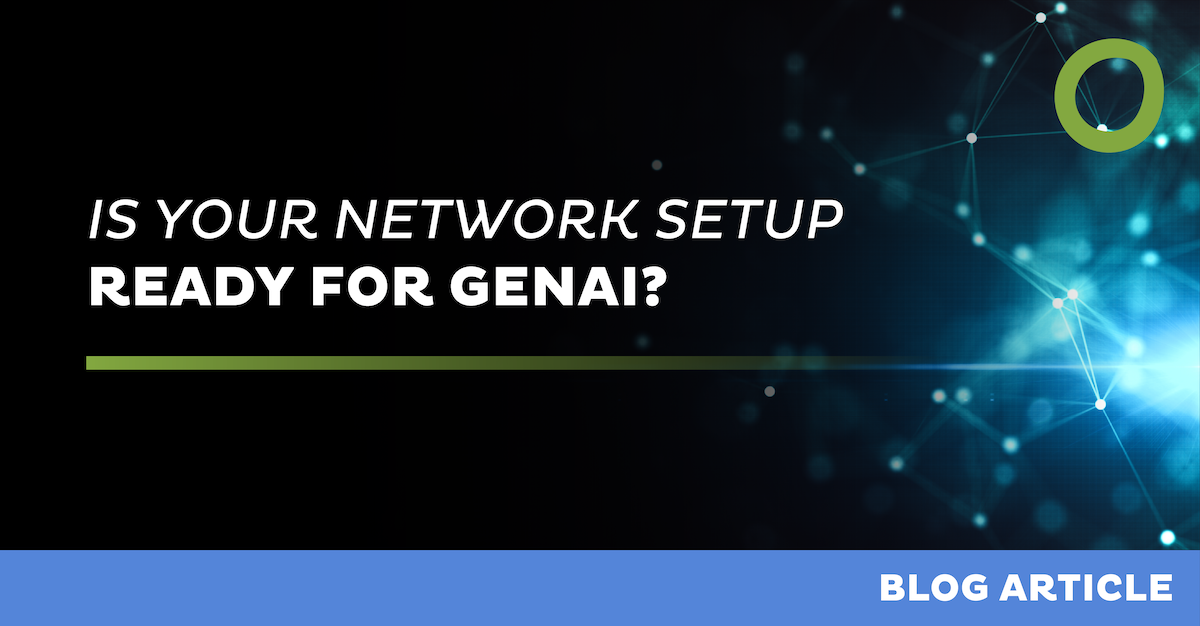
Is Your Network Setup Ready for GenAI?


Generative AI is no longer a novelty – it’s becoming a core driver of productivity and business innovation. Yet even the most powerful AI models can underperform if networks are slow, unreliable, or poorly optimized. Ensuring seamless connectivity is essential to unlock GenAI’s full potential and deliver consistent results across the enterprise.
According to Gartner, worldwide enterprise spending on Generative AI is projected to reach $14.2 billion in 2025, a 148% increase from the previous year. What began as employees experimenting with quirky prompts has quickly evolved into a powerful driver of productivity and operational efficiency. In record time, organizations across various industries have recognized its potential to accelerate workflows, reduce repetitive tasks, and deliver actionable insights, transforming GenAI from a curiosity into a business-critical capability.
Why network and connectivity make or break AI deployments
While GenAI offers immense potential, deploying it across enterprises comes with significant challenges. GenAI workloads are extremely data-intensive and span multiple environments: some processing happens on edge devices, other tasks run on premises, and much of the computation occurs in distant cloud regions hosting the AI models and SaaS services they rely on. Even the most advanced AI models can underdeliver if data cannot flow efficiently and reliably between these environments. Latency, bandwidth, network reliability, and the proximity of endpoints to AI resources play a critical role in overall performance. The connectivity and network layers have quietly become the make-or-break factor for reliable, deterministic AI performance.
- Network availability and end-to-end reliability
GenAI relies on continuous, uninterrupted connectivity across the entire data and compute chain. Its distributed nature makes end-to-end reliability particularly challenging. Network outages, unstable last-mile connections, or congested backbone links can cause latency spikes, inconsistent throughput, or data loss. Such disruptions degrade performance, impact business processes, erode trust in GenAI applications, and result in slow adoption. For example, a customer-facing chatbot may fail, leaving customers waiting, employees unable to manage workloads efficiently, and critical support workflows stalled.A reliable GenAI architecture requires a holistic approach to connectivity and SD-WAN design, ensuring that if one component fails or degrades, others can automatically compensate. On the connectivity side, redundancy and multiple last-mile options safeguard against ISP outages, such as cable cuts or local disruptions. Within the SD-WAN layer, dynamic routing and automatic failover address the path or routing issues in real time, keeping data flowing smoothly. In addition, comprehensive monitoring, automated self-healing, and 24×7 expert support help minimize downtime and maintain consistent responsiveness across regions, ensuring that GenAI applications remain reliable. - Consistent low latency and minimal jitter
Low latency and minimal jitter are essential for real-time GenAI applications. For instance, a GenAI copilot in collaborative document editing or code generation needs near-instant responses to be useful. High latency or jitter leads to delays in response generation, which interrupts workflow and frustrates users.Consistent low latency depends on resilient backbone and last-mile connections, supported by strategically placed points of presence (PoPs) near AI data centers. On top of this, SD-WAN enables dynamic, performance-based routing that prevents inefficient backhauling through hubs, ensuring steady performance for latency-sensitive workloads. Prioritizing latency-sensitive GenAI traffic ensures that copilots, chatbots, and real-time analytics agents stay responsive, boosting productivity, enabling faster data-driven decisions, as well as driving better business outcomes. - Bandwidth and high throughput
Most GenAI applications handle large datasets or perform complex inference. Training models, fine-tuning them on enterprise data, and updating them across multiple locations all involve significant data transfer. Insufficient bandwidth or throughput can slow copilots, delay content generation, or make analytics assistants less responsive or less accurate. For instance, an e-commerce recommendation engine depends on constant access to large transaction datasets – any bandwidth limitations can delay recommendations and impact conversions.High throughput at scale can be achieved by aggregating several access lines virtually through SD-WAN to form a large, efficient data pipe. Dedicated internet access (DIA) often provides more bandwidth for less cost compared with legacy MPLS, improving ROI for AI connectivity investments. For all the relevant data needed to build a network business case, see this white paper. - Global coverage and proximity to cloud/edge/PoPs
The proximity of GenAI users to hosted models is a key performance factor. Workloads placed closer to edge nodes or cloud PoPs experience lower latency and faster data transfer, improving responsiveness of AI applications. Global organizations must also account for distributed teams and regions with connectivity constraints – such as China, South America or Africa where access to international cloud services can add latency. Without a global coverage strategy, GenAI applications that rely on real-time data (such as quality-control assistants analyzing sensor data or trading assistants processing market information) may receive input too slowly, leading to outdated insights, delayed decisions, and reduced effectiveness.High-performance backbone connectivity, combined with local access in remote or constrained regions, supported by an end-to-end SLA, provides the peace of mind and offers reliability needed for consistent GenAI operation. On top of it, application visibility, traffic prioritization, and optimization keep GenAI performance consistent worldwide. - Traffic visibility and prioritization
GenAI workloads compete with other enterprise traffic, and without proper traffic management, mission-critical applications can slow down. For example, R&D simulation tools may extend innovation cycles, or internal knowledge management systems may respond inconsistently, all reducing productivity and impacting business outcomes.Through SD-WAN with its quality of service (QoS) policies, AI traffic can be prioritized above less critical workloads. This ensures deterministic inference – consistent, reliable AI performance – across mixed enterprise environments. - Managed network and connectivity
GenAI applications are only as effective as the networks that support them. Without proactive monitoring and optimization, performance bottlenecks can go unnoticed until users experience delays or errors. For example, a manufacturing team relying on a GenAI assistant to analyze production data or generate maintenance schedules may face delayed insights, incomplete reports, and a higher risk of downtime or quality issues.A managed connectivity approach with continuous monitoring, automated failover, and self-healing ensures issues are detected and resolved before they affect users and production. Combined with 24×7 expert-level operations, enterprises gain predictable performance and reduced operational risk for their GenAI workloads.
Reliable networks: the foundation for scalable GenAI
The performance of GenAI applications depends not only on model sophistication but also on the reliability, throughput, and manageability of the networks connecting them. Faster, predictable AI responses enhance user experience, while stable, high-capacity connectivity allows models to operate efficiently at scale – reducing delays, minimizing errors, and maximizing the value of each inference. End-to-end visibility, holistic monitoring, and traffic prioritization also support compliance and governance.
To fully realize AI investments, enterprises must assess their network readiness for GenAI. Deterministic AI requires deterministic connectivity – resilient, global, and intelligently managed.
Open Systems delivers end-to-end managed connectivity and SD-WAN with 24×7 operations and global SLAs, helping enterprises ensure that their GenAI deployments are as reliable, scalable, and as intelligent as the models they power.
Is your network ready for GenAI?
Leave Complexity
Behind
To learn how Open Systems SASE Experience can benefit your organization, talk to a specialist today.
Contact Us



